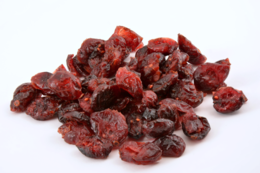Dried cranberry
This article needs additional citations for verification. (October 2009) |

Dried cranberries are made by partially dehydrating fresh cranberries, a process similar to making grapes into raisins. They are popular in trail mix, salads, breads, with cereals, or eaten on their own. Dried cranberries are sometimes referred to as craisins due to the name's similarity to raisins, though the word "Craisin" is a registered trademark of Ocean Spray Cranberries, Inc.[1] and cannot be officially applied to dried cranberries from other manufacturers.
Most commercially produced dried cranberries contain added sugar, and they may also be coated in very small quantities of vegetable oil to keep them from sticking together.[citation needed]
Many home recipes for dried cranberries involve allowing the cranberries to sit overnight in a water and sugar solution, prior to freeze-drying or air-drying. This can deprive the cranberries of some natural nutrients that would be contained in fresh cranberries.[citation needed]
Benefits
Dried cranberries contain the same nutrients as fresh cranberries (notably dietary fiber and antioxidants). However, commercial drying processes substantially reduce the vitamin A and vitamin C content. The nutrient density is also reduced if sugar is added.
The nutrition facts for dried cranberries vary significantly depending on the brand. Nutrition facts for 1/3 cup (40 g) of Ocean Spray dried cranberries are as follows:[2]
- Calories: 123 kcal
- Fat: 0.6 g
- Sodium: 1 mg
- Total Carbs: 24 g
- Dietary Fiber: 2 g
- Sugars: 22 g
- Protein: 0 g
Dried cranberries contain no cholesterol, or saturated or trans fats.[2] Consuming dried cranberries will supply very little amounts of an individual's daily requirement for vitamins and minerals.[3] The most substantial daily amount supplied is the mineral manganese, at 5% of the daily recommended intake.[3] Having 1/4 cup of dried cranberries will supply one serving of fruits and vegetables, 25% of the daily recommendation from the USDA.[4] The Canadian food guide recommends 7–10 servings of fruits and vegetables daily to reduce stroke, heart disease, and cancer risks.[5][6] In the United States and Canada, Craisins are also considered to be a nut free product.[7]
Cranberries with minimal processing contain the highest amount of antioxidants,[8] although dried cranberries retain some antioxidants.[9]
Some antioxidants include phenolic acids, flavonoids, proanthocyanidins, and anthocyanin.[8] It is the anthocyanin that provides pigment to supply cranberries with their robust red color.[8]
The added sugar can be a drawback for this product. Essentially, the sugar is added to improve texture and water content, and to reduce tartness.[10]
Dried cranberries made with less sugar may be helpful for individuals with Type 2 Diabetes.[11] Because less sugar is added, there is a lower glycemic index and thus less of an insulin response occurs.[11] However, this has not been the case in recent studies of participants with higher response times on glycemic intake/glucose output testing batteries.[citation needed]
Uses
Dried cranberries can be used as an addition in various foods including salads, oatmeal, cookies, muffins, loaves, breads and trail mix. They can act as a direct replacement for raisins or any dried fruit. Because dried cranberries are a dried fruit, spoilage is less of a concern than for fresh fruit.[10] Dried cranberries can be a useful product to carry while traveling because of their extended shelf life.
Dried cranberries are sometimes packaged with other flavorings. Dried cranberries can also come covered in chocolate.[12]
See also
References
- ^ "Craisins". Ocean Spray Cranberries, Inc. Retrieved 2009-11-02.
- ^ a b "Archived copy". Archived from the original on 2011-11-07. Retrieved 2011-11-07.
{{cite web}}: CS1 maint: archived copy as title (link) - ^ a b "Cranberries, dried, sweetened Nutrition Facts & Calories". nutritiondata.self.com. Retrieved 6 July 2018.
- ^ "Archived copy". Archived from the original on 2011-11-18. Retrieved 2011-11-07.
{{cite web}}: CS1 maint: archived copy as title (link) - ^ Canada, Health. "Food Guide Basics - Canada.ca". www.hc-sc.gc.ca. Retrieved 6 July 2018.
- ^ Canada, Health. "How Much Food You Need Every Day - Canada.ca". www.hc-sc.gc.ca. Retrieved 6 July 2018.
- ^ "Archived copy". Archived from the original on 2011-11-21. Retrieved 2011-11-07.
{{cite web}}: CS1 maint: archived copy as title (link) - ^ a b c "Cranberries". www.whfoods.com. Retrieved 6 July 2018.
- ^ "Holiday Fruit Ranks Number One In Antioxidants". Retrieved 6 July 2018.
- ^ a b Wilson, T., Luebke, E.F., Carrell, M.C., Leveranz, L. K., Schmidt, T.P., Limburg, P.J., Vorsa, N. & Singh, A.P. Glycemic Responses to Sweetened Dried and Raw Cranberries in Humans with Type 2 Diabetes. "Journal of Food Science", vol. 75 (8), pp. H218-223. 2010.
- ^ a b "Cranberries offer promise for diabetics: Study". Retrieved 6 July 2018.
- ^ "BROOKSIDE Chocolate - Bold and Ballsy Dark Chocolate". www.clodhoppers.tv. Archived from the original on 17 July 2012. Retrieved 6 July 2018.
